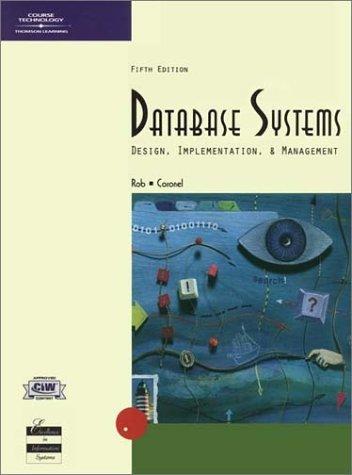Question
Design is a never ending process of revisions. Like a paper or like software alpha, beta, or release versions. First drafts let me give feedback
- Design is a never ending process of revisions. Like a paper or like software alpha, beta, or release versions. First drafts let me give feedback so I can be harsher on the 2nd draft and final.
- It is fictional; maybe you plan to actually make it but I don't care. Get it done here on time then make it something better.
- DESIGN. This is not an art class; however, the site has to look professional and be easy to use (yes, unlike my class website.) I'm trying to have more design thinking work involved than technical work.
- Make you spread out your thinking on it and not procrastinate; therefore, being on time matters for these assignments.
- Ideally, at the end of class you have a design or a prototype you could demo to somebody. Even better, use it in other classes to make it even better. I have a friend in Silicon Valley without a degree, he uses prototypes he makes on his own time to get jobs. They partially work but he demos the prototype so they don't know just how much he made for fun. It's impressive as hell to have somebody show a good looking hobby project; especially when you don't know that 75% of it is incomplete.
PROTOTYPING REDUCES RISK
Memorize those 3 words!
Revision, experiment, explore, even test, imagine, role play. Upfront investment is cheap! The longer you go before changes (bugs,feedback,new ideas) happen the more costly and risky it becomes!
Well begun is half done. -Aristotle
Requirements
- NO actual HTML/CSS should be done! You touch on everything a bit but nothing need be completely done or polished. This is an overview.
-
Thought about your DESIGN, using as many issues you can pull in from the book. Convey these using text (please avoid handwriting as much as possible,) Drawings, Power points, outlines, photos, diagrams, screenshots with arrows on them... images of other websites. You can collage print outs from other websites and copy/paste them on actual paper.
- Navigation for the website should be an outline at least, if not a basic mock up drawing/sketch. You should know WHY you picked those topics and words for the navigation links. Why is it at the side? top? why only 4 of them? why sub categories? etc.
- Navigation for a web app may differ greatly - if you are doing an app. Probably the menu can be considered the navigation; if it is an app without a menu; such as a phone app then the buttons used can be presented as an outline with the topics being modes or screens the app is in when those buttons appear on screen.
- You may include links to other sites, drawings or scans of stuff you did on paper. (It's easier to begin this stuff on paper at least before you stick it into the computer.) Ah, I don't want Microsoft documents. pdf, jpegs,...open standard files are fine. I will also accept paper arts-and-crafts on 8.5x11 paper sized sheets I can take photos of or scan (if you can't do it for me.)
-
Kinds of thoughts I like to see such as, guidelines used (think of these as a checklist to look over for each decision:) I expect some documentation showing me you did think of these. The only purpose of documentation is to prove to me you thought about it; otherwise, at least try to think about multiple compromise situations (you don't have to write down every decision! please think a lot and write down a little.) Here are some main areas to think about (from the book:)
- Visual Structure: Gestalt concepts (proximity, similarity, common fate, etc.)
- Vision: reading, color, peripheral (ads navigation, error display)
-
Intro chapter of book has multiple checklists
- Predictable (from )
- Accessible ( drag an drop required? video? how are you going to handle blind people? people bad at english? )
- Feedback ( show the user where they are, like navigation - more detailed for apps )
- Tolerant (for a plain website, this can be multiple links to get somewhere, back links to the home page, etc. responsive design .. smart phones)
- Recognition vs Recall (do they have to remember/memorize anything?)
- Tasks (more of an app thing, but navigation paths of a plain website qualify)
- Structured (visual, and content, and navigation, page layout)
- User control (user isn't stuck in 1 path without a way out... they shouldn't have to use the BACK button.)
-
Obvious stuff (so much so I keep forgetting:)
- GOAL / PURPOSE
- WHO? what kind of users do you expect to have?
- What are the GOAL(s) for the user (did you think of yourself when Goal was listed above?)
- What are the TASKS the users will want to do? (to achieve those goals)
Step by Step Solution
There are 3 Steps involved in it
Step: 1

Get Instant Access to Expert-Tailored Solutions
See step-by-step solutions with expert insights and AI powered tools for academic success
Step: 2

Step: 3

Ace Your Homework with AI
Get the answers you need in no time with our AI-driven, step-by-step assistance
Get Started


